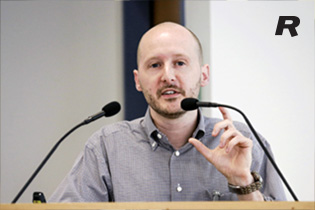 Whether you’re getting a startup off the ground or running a large corporation, most people would agree that the secret to staying competitive today is innovation. But how do you go about creating or finding spaces that inspire creativity and imagination?
Whether you’re getting a startup off the ground or running a large corporation, most people would agree that the secret to staying competitive today is innovation. But how do you go about creating or finding spaces that inspire creativity and imagination?
This question is at the centre of Professor Alberto Galasso’s research. Galasso, who is an Associate Professor of Strategic Management at Rotman, studies the factors underlying innovation.
His research has been published in a number of journals and he recently authored, with Professor Ajay Agrawal, a chapter in Survive and Thrive: Winning Against Strategic Threats to Your Business, on why young companies need to consider location in their strategic planning.
“Don’t be afraid to venture outside your comfort zone.”
—Alberto Galasso, Associate Professor, Strategic Management
Here are a few insights that anyone working in the innovation space — from budding entrepreneurs to CEOs at established firms — should know:
You need to have a solid intellectual property strategy for innovation.
“When people think about innovation, they tend to think about it too narrowly,” explains Galasso. “Most companies focus too much on R&D and have the end goal of owning and patenting a new technology.”
Galasso has published a number of papers exploring the patent system and how it might help or hinder innovation.
Based on his findings and observations, he advises companies to think of an innovation plan that will work best for them.
“Focus on the market for the technology and the future for the invention,” says Galasso. “You might not want to pursue an aggressive patent litigation strategy, but instead consider opportunities to partner with other firms that might enhance your offering.”
Be confident — and go beyond your network.
When it comes to innovation, it pays to think confidently.
Previously, Galasso has examined why over-confident CEOs — the type of leaders that often rush into bad business deals — are so successful.
It’s actually quite simple, says Galasso.
“The same traits that might lead these leaders, somewhat blindly, into making bad decisions are also likely to move their companies in unexpected directions and help them innovate,” he says.
It also helps to talk to lots of people from outside of your network.
“One thing that the research has shown us is that talking to people outside your team or company can give you access to a lot of new ideas,” he adds. “Don’t be afraid to venture outside your comfort zone.”
A startup’s success often depends on its location.
In their previous work, looking at why certain regions were more innovative than others and how transportation systems influence innovation, Professors Galasso and Agrawal have identified a few different ways in which the dynamics of a city might impact innovation.
As they summarize in Survive and Thrive, there are eight crucial factors — investors, customers, suppliers, labour pool, competition, institutions, culture and social network — that every emerging startup should consider when selecting a location as their home base.
“The decision on where to locate your company is not an easy one to make. You need to think through all eight elements and weigh them carefully,” says Galasso. “For example, when Amazon was starting out, they selected Seattle as a home base so that they could be close to book publishers and suppliers. Other groups, like technology companies, might want to be near a community that ‘gets’ tech so that they can get the necessary investment and support to develop and grow further.”
In terms of innovation, there are things that Toronto could be doing better.
We’re lagging behind other emerging cities when it comes to having managers with experience in scaling up companies, says Galasso. That’s why programs like the Creative Destruction Lab at Rotman — where experienced venture capitalists, scientists and business professionals mentor and scale-up promising, growth stage companies — are critical to the city’s future.
Generally, Toronto is a good city to launch a startup and for growth.
“We have a diverse and qualified workforce. There’s a good chance that new companies can find the right talent here,” says Galasso.
He also points out that Canada’s strong immigration policy is helpful in attracting highly-skilled talent to the city. And the presence of academic and research institutions has been key to supporting innovation.
“We’re on a good path in Toronto. We’ve made some great technological breakthroughs in AI which puts us at a definite advantage. At the same time, we have a lot of very ambitious people with great ideas who are willing to work hard.”
Written by Rebecca Cheung | More Rotman Insights »
Photo above: Alberto Galasso presented his Findings on the Relationship Between Patent Rights and Cumulative Innovations at the "Conference on the Economics of Innovation and Patenting." Photo source.